Power electronic handbook
Подождите немного. Документ загружается.

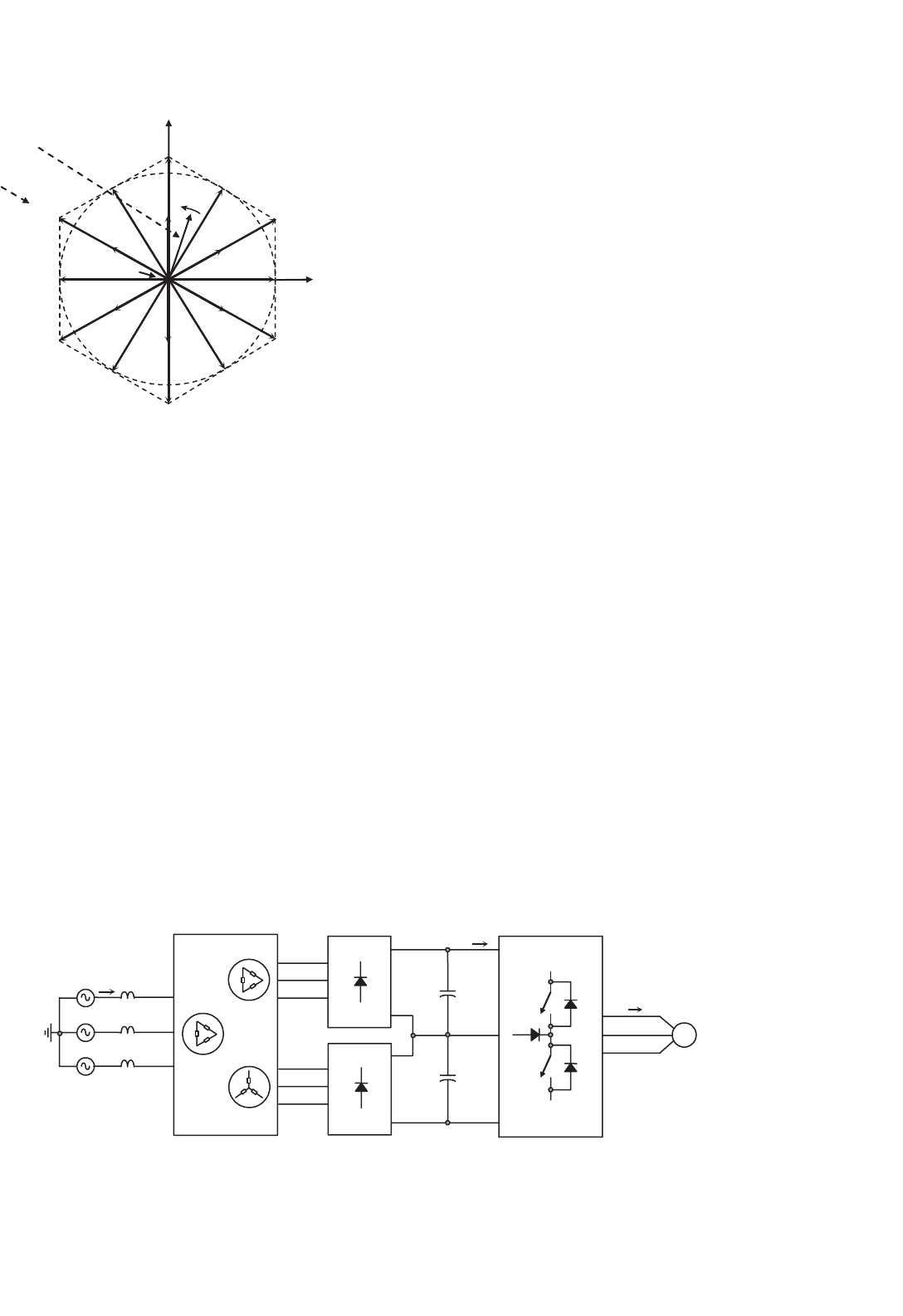
398 J. R. Espinoza
modulating
vector
state
α
β
ω
v
10
→
v
11
→
v
12
→
v
1
→
v
2
→
v
3
→
v
4
→
v
5
→
v
6
→
v
7
→
v
8
→
v
9
→
v
c
=
→
v
c
αβ
→
v
21, 22
→
v
19, 20
→
v
17,18
→
→
v
25, 26, 27
→
v
23, 24
→
→
v
13,14
v
15,16
FIGURE 15.62 The space-vector representation in a three-level VSI.
Indeed, for a N level inverter, N − 1 independent dc voltage
supplies are required that could be provided by N −1 six-pulse
rectifiers feed from an N − 1 -pulse transformer. Therefore,
the ac main currents is a N −1 level type of waveform.
This approach cannot be used when the inverter does not
feature dc link voltage supplies. This is the case of static power
reactive power compensators and static power active filters.
In this case, the proper gating of the power valves becomes
the only choice to keep and balance the dc link voltages.
Figure 15.64a shows this case where the current added by the
inverter i
abc
o
provides the reactive power and current harmon-
ics such that the ac mains current i
abc
s
features a given power
factor.
The SPWM modulating technique could be used as in
Fig. 15.60; however, the zero level of the carriers δ is left
as a manipulable variable Fig. 15.64b. In fact, it is used to
ac
mains
v
as
i
sa
12-pulse
transformer
N
+
−
+
−
v
i
/2
C
+
C
−
i
oa
six-pulse
rectifiers
three-level
VS inverter
i
i
IM
v
i
/2
FIGURE 15.63 ASD based on a three-phase three-level VSI topology.
control the difference of the upper and lower capacitor volt-
ages v
i
= v
i1
− v
i2
. A closed loop alternative is depicted
in Fig. 15.64c to manipulate δ. The modulating signals v
abc
c
are left to control the reactive power and current harmonics
injected into the ac mains by regulating the currents i
abc
o
and
keep the total dc link voltage v
i
= v
i1
+v
i2
equal to a reference.
Both loops are not included in Fig. 15.64c.
15.7.3 Current Source-based
Multilevel Topologies
Duality is found in many aspects related to voltage and cur-
rent source inverters. Perhaps, the most evident is the duality
in terms of modulating techniques. Thus, current source based
multilevel topologies are available as well. As expected, all
the benefits and all the drawbacks found in voltage source
topologies should be found in current source topologies.
Figure 15.65 shows a three-level N = 3 current source
topology, which is formed by paralleling two standard six-
switches topologies. The main goal is to share evenly the ac
current i
abc
o
among the two topologies (i
abc
o
/2 = i
abc
o1
= i
abc
o2
).
This should be ensured by having equal dc link currents
(i
i1
= i
i2
). Similarly to voltages source based mutlilevel
topologies, this could be achieved by using either two indepen-
dent dc link currents or by properly gating the power valves.
Both alternatives are reviewed later on.
A. The SPWM Technique in Three-level CSIs
As in three-level VSIs, the main objective is to generate the
appropriate 12 gating signals so as to obtain fundamental
inverter line currents equal to a given set of modulating signals.
Specifically, the SPWM in three-level inverters uses a sinu-
soidal set of modulating signals (i
ca
, i
cb
, and i
cc
for phases
a, b, and c, respectively) and N − 1 = 2 triangular type of
carrier signals (i
1
and i
2
) as illustrated in Fig. 15.66a and
15.66e. The best results are obtained if the carrier signals are
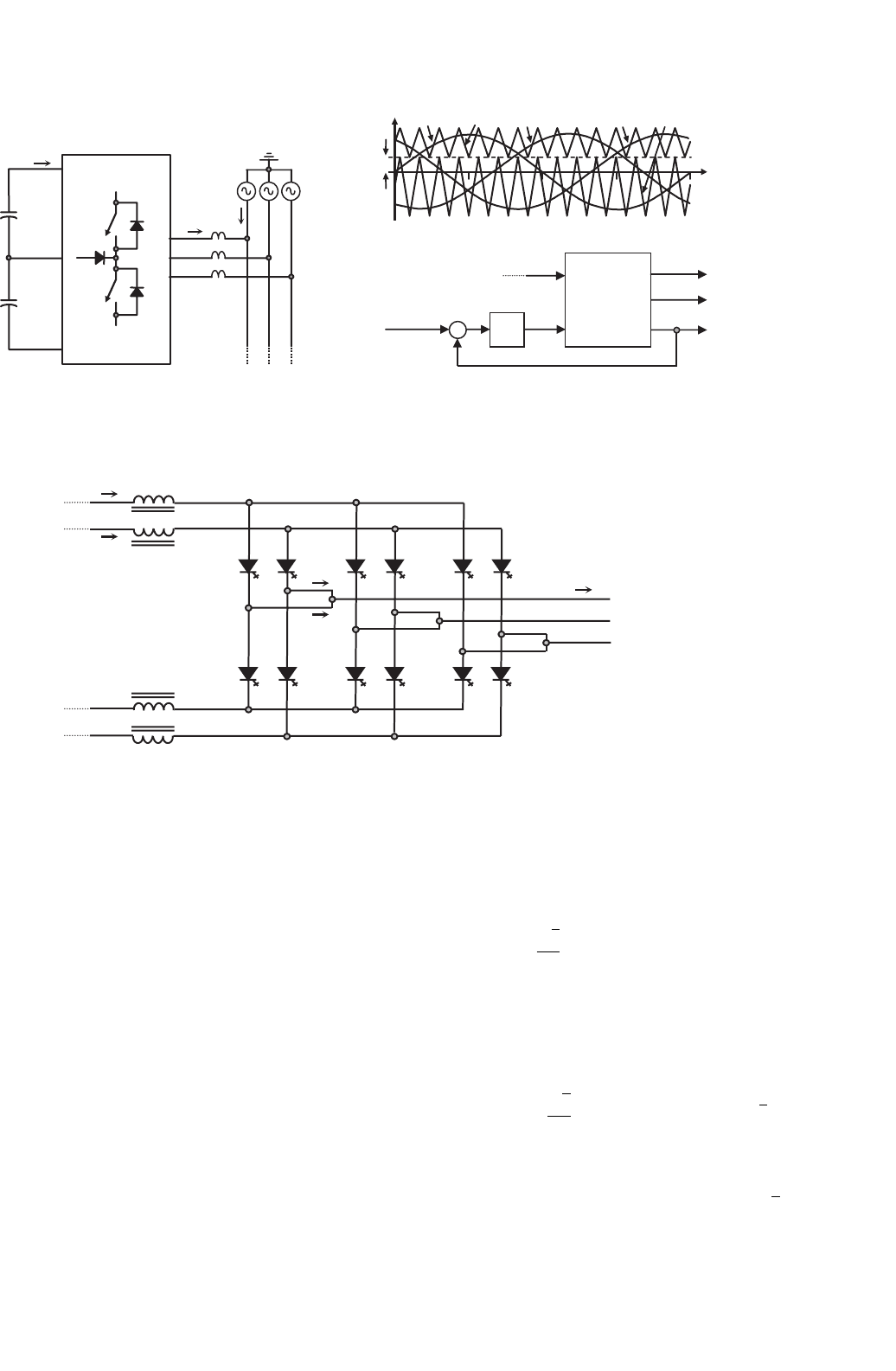
15 Inverters 399
v
ca
ωt
v
D1
v
D2
v
cc
v
cb
δ
(b)
ac
mains
v
as
i
sa
N
+
−
v
i1
+
−
v
i 2
C
+
C
−
i
oa
three-level
VS inverter
i
i
∆v
i ref
= 0
v
c
abc
δ
v
i
∆v
i
i
i
abc
three-level
three-phase
VS inverter
PI
+
−
(a) (c)
180
180 270 270 90 90 360 360 0 180 270 90 360 0
FIGURE 15.64 Reactive power and current harmonics compensator based on a three-phase three-level VSI topology: (a) power topology; (b) carrier
and modulating signals; and (c) δ closed loop scheme.
i
i2
i
i1
+
−
v
i1
+
−
v
i2
i
oa1
i
oa2
i
oa
L
dc
L
dc
+
−
v
ab
S
11
S
31
S
51
S
41
S
61
S
21
S
12
S
32
S
52
S
42
S
62
S
22
FIGURE 15.65 Three-phase three-level CSI topology.
180
◦
out of phase and feature an odd normalized frequency
(e.g. m
f
= 15). In order to use the same set of carrier signals to
generate the gating signals for phases b and c, the normalized
frequency of the carrier signal m
f
should be a multiple of 3.
Thus, the possible values are m
f
= 3, 9, 15, 21, ....
Figure 15.66 shows the relevant waveforms for a three-level
inverter modulated by means of a SPWM technique (m
f
= 15,
m
a
= 0.8). Specifically, Fig. 15.66b and 15.66f show the gat-
ing signals obtained as described earlier in this chapter. The
inverter line currents shown in 15.66c and 15.66g feature spec-
tra shown in 15.66d and 15.66h, respectively. As expected, the
inverter line currents contain harmonics at l · m
f
± k with
l = 1, 3, ...and k = 2, 4, ...and at l ·m
f
±k with l = 2, 4, ...
and k = 1, 3, .... For instance, the first set of harmonics in the
line currents (l =1, m
f
= 15) are at 15 ± 2, 15 ± 4, ....
The total inverter line current is shown in Fig. 15.67a,
and features the first set of unwanted harmonics around 2m
f
Fig. 15.67b. This becomes the first advantage of using a multi-
level topology as the filtering component requirements become
more relaxed. All the other features of carrier-based PWM
techniques also apply in current source multilevel inverters.
For instance: (I) the fundamental component of the line
currents satisfy
ˆ
i
oa1
=
ˆ
i
ob1
=
ˆ
i
oc1
= m
a
√
3
2
(i
i1
+i
i2
)0< m
a
≤ 1 (15.94)
where 0 < m
a
≤ 1 is the linear operating region. Also:
(II) to further increase the amplitude of the load currents,
a zero sequence signal could be injected to the modulating
signals, in this case
ˆ
i
oa1
=
ˆ
i
ob1
=
ˆ
i
oc1
= m
a
√
3
2
(i
i1
+i
i2
)0< m
a
≤ 2/
√
3
(15.95)
the overmodulation operating region can be used by further
increasing the modulating signal amplitudes (m
a
> 2/
√
3),
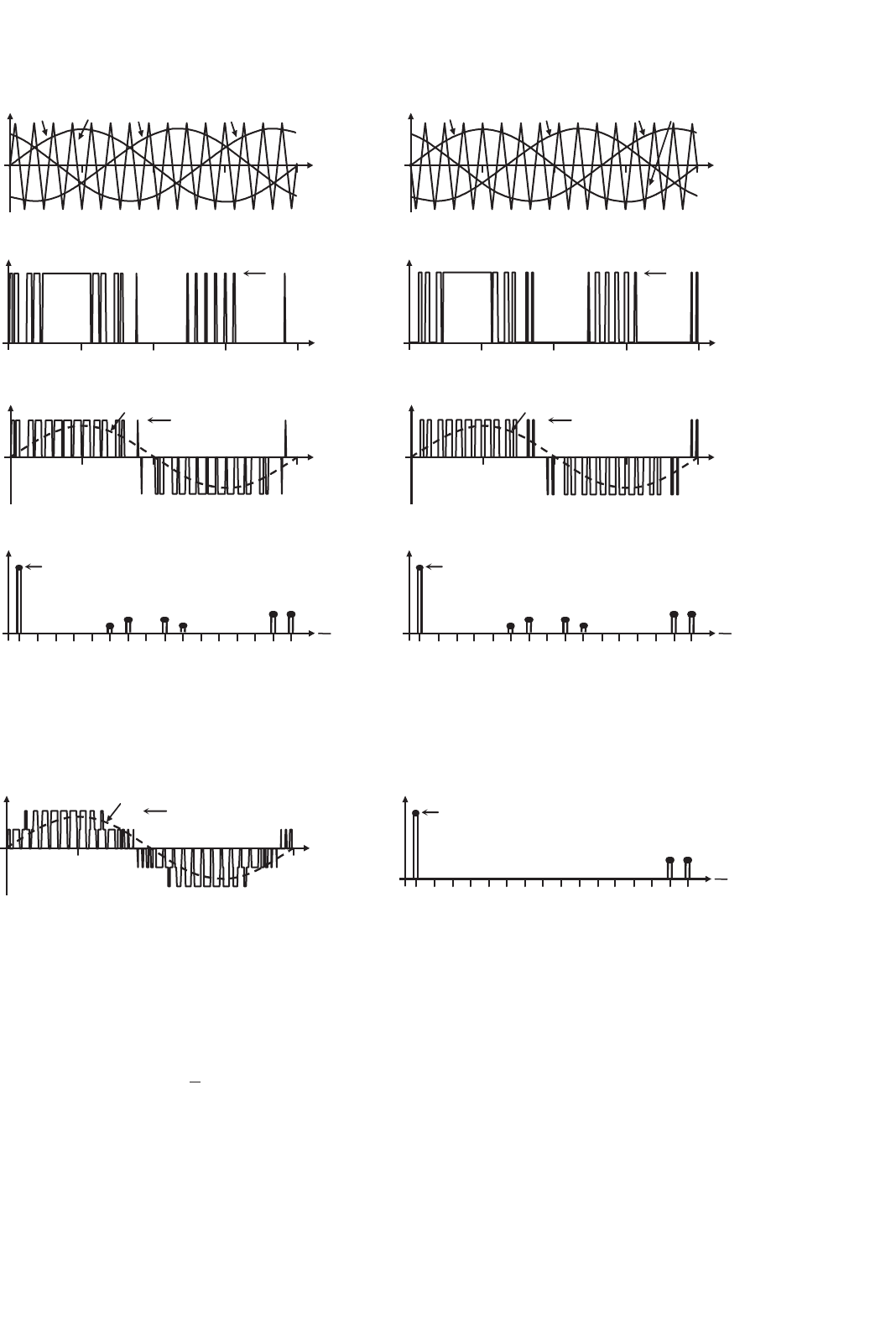
400 J. R. Espinoza
i
ca
i
ca
i
cb
i
cc
ωt
i
D1
i
cc
i
cb
ωt
i
D2
(a) (e)
180 27090 360
ωt
0
S
11
on
180 270 90 360
ωt
0
S
12
on
(b)
(f)
180 270 90 360
ωt
i
oa1
i
oa11
i
i 1
180 270 90 360
ωt
i
oa2
i
oa21
i
i 2
(c) (g)
1573 19 23 31271151 9 13 17 21 2925
i
oa1
f
f
o
0.8·i
i1
1573 19 23 31271151 9 13 17 21 2925
f
f
o
i
oa2
0.8·i
i 2
(d)
(h)
180 180 270 270 90 90 360 360 0
180
180 270 270 90 90 360 360 0
180 270 90 360 0
180 270 90 360 0
0
0
0
0
FIGURE 15.66 Three-level CSI topology. Relevant waveforms using a SPWM (m
f
= 15, m
a
= 0.8): (a) modulating signals and carrier signal 1;
(b) switch S
11
status; (c) inverter 1 linea current; (d) inverter 1 linea current spectrum; (e) modulating signals and carrier signal 2; (f) switch S
12
status; (g) inverter 2 linea current; and (h) inverter 2 linea current spectrum.
180 270 90 360
ωt
0
i
oa
i
oa1
i
i 1
+i
i 2
1573 19 23 31271151 9 13 17 21 2925
f
f
o
i
oa
0.8·i
i1
+0.8·i
i 2
(
a
)
(
b
)
FIGURE 15.67 Three-level CSI topology. Relevant waveforms using a SPWM (m
f
= 15, m
a
= 0.8): (a) total inverter line current and (b) total
inverter line current spectrum.
where the line currents range in
(i
i1
+i
i2
) <
ˆ
i
oa1
=
ˆ
i
ob1
=
ˆ
i
oc1
<
4
π
(i
i1
+i
i2
) (15.96)
Also: (III) a nonsinusoidal set of modulating signals could
also be used by the modulating technique. This is the case
where nonsinusoidal line currents are required as in active
filter applications; and (IV) because of the two quadrants oper-
ation of CSIs, the multilevel inverter could equally be used in
applications where the active power flow goes from the dc
to the ac side or from the ac to the dc side. In general, for
an N -level inverter modulated by means of a carrier-based
technique, three modulating signals 120
◦
out-of-phase and
N − 1 carrier signals are required and the line currents in
the inverters have a peak value of i
i
/(N −1).
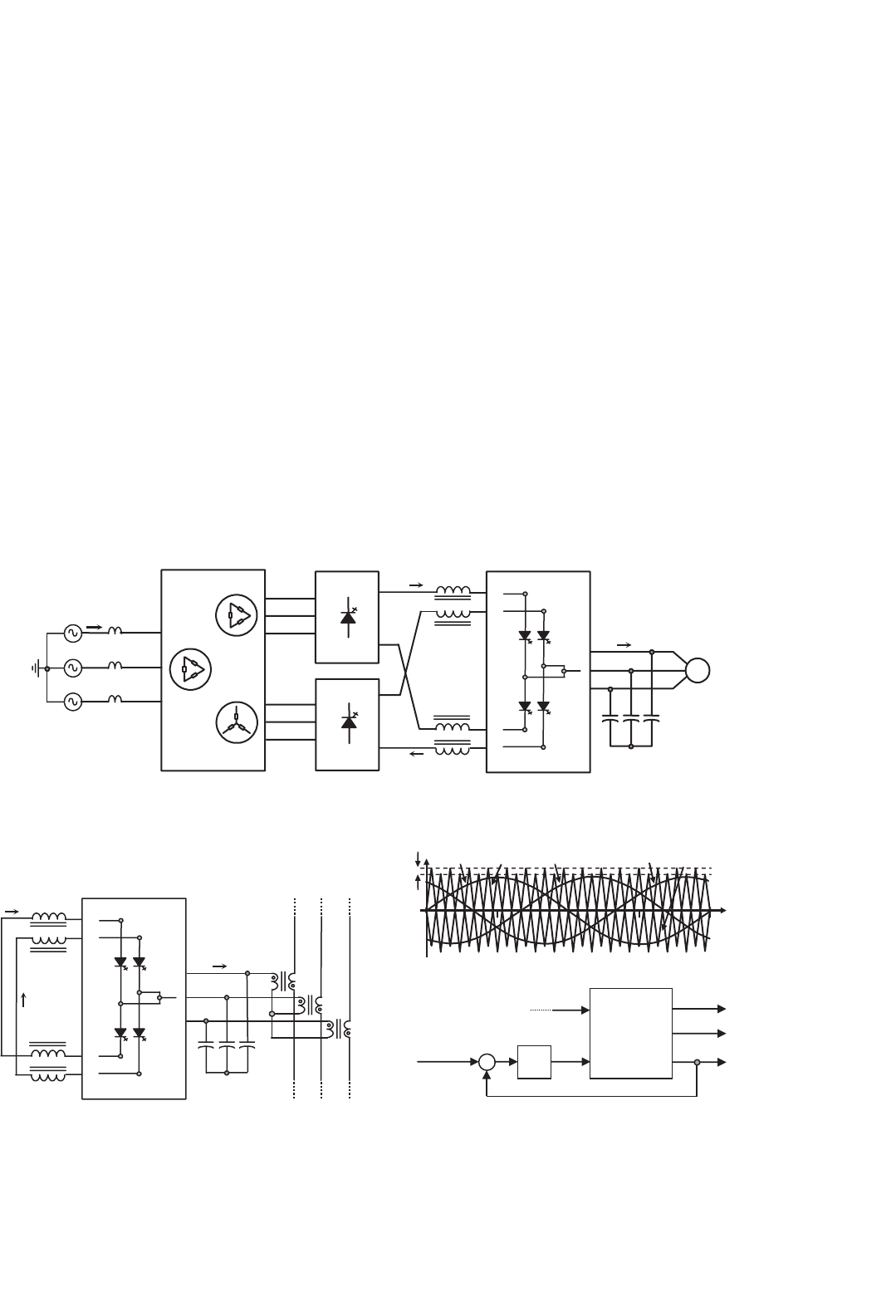
15 Inverters 401
One of the drawbacks of the multilevel inverter is that the dc
link capacitors cannot be supplied by a single dc voltage source.
This is due to the fact that the currents required by the inverter
in the dc bus are not symmetrical and therefore the capacitors
will not equally share the dc supply voltage v
i
. To overcome
this problem, two alternatives are developed later on.
B. DC Link Voltage Balancing Issues
Figure 15.65 shows a three-level inverter and the ideal wave-
forms are shown in Fig. 15.66 and Fig. 15.67, which assume
equal dc link currents, i
i1
= i
i2
. This even distribution is
not naturally achieved and could be overcome by supplying
the dc link inductors from independent supplies or properly
gating the power valves of the inverter in order to minimize
the unbalance.
Figure 15.68 shows an ASD based on a three-level current
source inverter, where the dc link inductors are feed from two
different sources. Unlike the VS topology, the scheme needs
a closed loop control strategy to keep constant the dc link
ac
mains
v
as
i
sa
12-pulse
transformer
i
oa
six-pulse
controlled rectifiers
three-level
CS inverter
i
i2
i
i1
L
dc
L
dc
IM
+
−
v
oa
FIGURE 15.68 ASD based on a three-phase three-level CSI topology.
2δ
i
ca
ωt
i
D1
i
D2
i
cc
i
cb
(b)
ac
mains
load
i
oa
three-level
CS inverter
i
i2
i
i1
L
dc
L
dc
nv
oa
+
−
v
oa
∆i
i ref
= 0
i
c
abc
δ
i
i
∆i
i
v
i
abc
three-level
three-phase
CS inverter
PI
+
−
(a) (c)
180
180 270 270 90 90 360 360 180 270 90 360 00
FIGURE 15.69 Reactive power and current harmonics compensator based on a three-phase three-level VSI topology: (a) power topology; (b) carrier
and modulating signals; and (c) δ closed loop scheme.
currents and equal to a given reference. This is achieved in
commercial units by using either phase-controlled rectifiers
or PWM rectifiers. Nevertheless, the multipulse transformer
required to provide isolated dc link currents improves the ac
mains current as in the VS multilevel topology.
This approach cannot be used when the inverter is not feed
from an external power supply. This is the case of static series
voltage compensators. In this case, the proper gating of the
power valves becomes the only choice to keep and balance the
dc link currents. Figure 15.64a shows this case where the volt-
age added by the inverter nv
abc
o
compensates the sags and/or
swells present in the ac mains in order to provide a constant
voltage to the load.
The SPWM modulating technique could be used as in
Fig. 15.66 and Fig. 15.67; however, the peak amplitude of one
triangular is amplified in the factor 1 +δ and the peak ampli-
tude of other triangular is amplified in the factor 1 −δ, where
δ is left as a manipulable variable Fig. 15.69b. In fact, δ is used
to control the difference of the dc link currents i
i
= i
i1
−i
i2
.

402 J. R. Espinoza
A closed loop alternative is depicted in Fig. 15.69c to manipu-
late δ. The modulating signals i
abc
c
are left to control the series
injected voltage into the ac mains by regulating the voltages
v
abc
o
and keep the total dc link current i
i
= i
i1
+i
i2
equal to a
reference. Both loops are not included in Fig. 15.69c.
Acknowledgment
The author is grateful for the financial support from the
Chilean Fund for Scientific and Technological Development
(FONDECYT) through project 105 0958.
Further Reading
Inverters Applications
1. Chih-Yi Huang, Chao-Peng Wei, Jung-Tai Yu, and Yeu-Jent Hu ,
“Torque and current control of induction motor drives for inverter
switching frequency reduction,” IEEE Trans. Industrial Electronics,
52: (5), 1364–1371 (2005).
2. J. Rodriguez, L. Moran, J. Pontt, J. Espinoza, R. Diaz, and E. Silva,
“Operating experience of shovel drives for mining applications,” IEEE
Trans. Industry Applications, 40: (2), 664–671 (2004).
3. J. Espinoza, L. Morán, and J. Guzmán“Multi-level three-phase
current source inverter based AC drive for high performance
applications,” Conf. Rec. PESC’05, Recife, Brazil, June 2005.
4. G. Joós and J. Espinoza, “Three phase series var compensation
based on a voltage controlled current source inverter with supple-
mental modulation index control,” IEEE Trans. Power Electronics,
15: (3), 587–598 (1999).
5. P. Jain, J. Espinoza, and H. Jin, “Performance of a single-stage UPS
system for single-phase trapezoidal-shaped ac voltage supplies,” IEEE
Trans. Power Electronics, 13: (5), 912–923 (1998).
6. H. Akagi, “The state-of-the-art of power electronics in Japan,” IEEE
Trans. Power Electronics, 13: (2), 345–356 (1998).
7. T. Wu and T. Yu, “Off-line applications with single-stage converters,”
IEEE Trans. Industry Applications, 44: (5), 638–647 (1997).
8. H. Akagi, “New trends in active filters for power conditioning,” IEEE
Trans. Industry Applications, 32: (6), 1312–1322 (1996).
9. J. Espinoza and G. Joós, “A current source inverter induction motor
drive system with reduced losses,” IEEE Trans. Industry Applications,
34: (4), 796–805 (1998).
10. M. Ryan, W. Brumsickle, and R. Lorenz, “Control topology options
for single-phase UPS inverters,” IEEE Trans. Industry Applications,
33: (2), 493–501 (1997).
11. A. Jungreis and A. Kelly, “Adjustable speed drive for residential
applications,” IEEE Trans. Industry Applications, 31: (6), 1315–1322
(1995).
12. K. Rajashekara, “History of electrical vehicles in General Motors,”
IEEE Trans. Industry Applications, 30: (4), 897–904 (1994).
13. B. Bose, “Power electronics and motion control – Technology status
and recent trends,” IEEE Trans. Industry Applications, 29: (5),
902–909 (1993).
14. S. Bhowmik and R. Spée, “A guide to the application-oriented selec-
tion of ac/ac converter topologies,” IEEE Trans. Power Electronics,
8: (2), 156–163 (1993).
Current Source Inverters
15. J. Espinoza, L. Morán, and N. Zargari “Multi-level three-phase
current source inverter based series voltage compensator,” Conf.
Rec. PESC’05, Recife, Brazil, June (2005).
16. M. Pande, H. Jin, and G. Joós, “Modulated integral control technique
for compensating switch delays and nonideal dc buses in voltage-
source inverters,” IEEE Trans. Industrial Electronics, 44: (2), 182–190
(1997).
17. J. Espinoza and G. Joós, “Current-source converter on-line pattern
generator switching frequency minimization,” IEEE Trans. Industry
Applications, 44: (2), 198–206 (1997).
18. G. Joós, G. Moschopoulos, and P. Ziogas, “A high performance cur-
rent source inverter,” IEEE Trans. Power Electronics, 8: (4), 571–579
(1993).
19. Poh Chiang Loh and D.G. Holmes, “Analysis of multiloop control
strategies for LC/CL/LCL-filtered voltage-source and current-source
inverters,” IEEE Trans. Industry Applications, 41: (2), 644–654
(2005).
20. M. Salo and H. Tuusa, “Vector-controlled PWM current-source-
inverter-fed induction motor drive with a new stator current control
method,” IEEE Trans. Industrial Electronics, 52: (2), 523–531 (2005).
21. Dong Shen and P.W. Lehn, “Modeling, analysis, and control of a
current source inverter-based STATCOM,” IEEE Trans. on Power
Delivery, 17: (1), 248–253 (2002).
22. A. Bendre, I. Wallace, J. Nord, and G. Venkataramanan, “A current
source PWM inverter with actively commutated SCRs,” IEEE Trans.
Power Electronics, 17: (4), 461–468 (2002).
23. B.M. Han and S.I. Moon, “Static reactive-power compensator
using soft-switching current-source inverter,” IEEE Trans. Industrial
Electronics, 48: (6), 1158–1165 (2001).
24. D.N. Zmood and D.G. Holmes, “Improved voltage regulation for
current-source inverters,” IEEE Trans. Industry Applications, 37: (4),
1028–1036 (2001).
Modulating Techniques and Control Strategies
25. J. Espinoza and G. Joós, “DSP implementation of output volt-
age reconstruction in CSI based converters,” IEEE Trans. Industrial
Electronics, 45: (6), 895–904 (1998).
26. M. Kazmierkowski and L. Malesani, “Current control techniques for
three-phase voltage-source PWM converters: A survey,” IEEE Trans.
Industrial Electronics, 45: (5), 691–703 (1998).
27. A. Tilli and A. Tonielli, “Sequential design of hysteresis current con-
troller for three-phase inverter,” IEEE Trans. Industrial Electronics,
45: (5), 771–781 (1998).
28. D. Chung, J. Kim, and S. Sul, “Unified voltage modulation technique
for real-time three-phase power conversion,” IEEE Trans. Industry
Applications, 34: (2), 374–380 (1998).
29. L. Malesani, P. Mattavelli, and P. Tomasin, “Improved constant-
frequency hysteresis current control of VSI inverters with simple
feed-forward bandwidth prediction,” IEEE Trans. Industry Applica-
tions, 33: (5), 1194–1202 (1997).
30. M. Rahman, T. Radwin, A. Osheiba, and A. Lashine, “Analysis of cur-
rent controllers for voltage-source inverter,” IEEE Trans. Industrial
Electronics, 44: (4), 477–485 (1997).
31. A. Trzynadlowski, R. Kirlin, and S. Legowski, “Space vector PWM
technique with minimum switching losses and a variable pulse rate,”
IEEE Trans. Industrial Electronics, 44: (2), 173–181 (1997).

15 Inverters 403
32. S. Tadakuma, S. Tanaka, H. Naitoh, and K. Shimane, “Improvement
of robustness of vector-controlled induction motors using feedfor-
ward and feedback control,” IEEE Trans. Power Electronics, 12: (2),
221–227 (1997).
33. J. Holtz and B. Beyer, “Fast current trajectory tracking control
based on synchronous optimal pulse width modulation,” IEEE Trans.
Industry Applications, 31: (5), 1110–1120 (1995).
34. J. Espinoza, G. Joós, and P. Ziogas, “Voltage controlled current source
inverters,” Conf. Rec. IECON’92, San Diego CA, USA, pp. 512–517,
November (1992).
35. Fei Wang, “Sine-triangle versus space-vector modulation for three-
level PWM voltage-source inverters,” IEEE Trans. Industry Applica-
tions, 38: (2), 500–506 (2002).
36. K.K. Tse, Henry Shu-Hung Chung; S.Y. Ron Hui, and H.C. So,
“A comparative study of carrier-frequency modulation techniques
for conducted EMI suppression in PWM converters,” IEEE Trans.
Industrial Electronics, 49: (3), 618–627 (2002).
37. K.L. Shi and H. Li, “Optimized PWM strategy based on genetic
algorithms,” IEEE Trans. Industrial Electronics, 52: (5), 1558–1561
(2005).
Overmodulation
38. A. Hava, S. Sul, R. Kerkman, and T. Lipo, “Dynamic overmodulation
characteristics of triangle intersection PWM methods,” IEEE Trans.
Industry Applications, 35: (4), 896–907 (1999).
39. A. Hava, R. Kerkman, and T. Lipo, “Carrier-based PWM-VSI over-
modulation strategies: Analysis, comparison, and design,” IEEE
Trans. Power Electronics, 13: (4), 674–689 (1998).
40. Bon-Ho Bae and Seung-Ki Sul, “A novel dynamic overmodulation
strategy for fast torque control of high-saliency-ratio AC motor,”
IEEE Trans. Industry Applications, 41: (4), 1013–1019 (2005).
41. Hee-Jhung Park and Myung-Joong Youn, “A new time-domain dis-
continuous space-vector PWM technique in overmodulation region,”
IEEE Trans. Industrial Electronics, 50: (2), 349–355 (2003).
42. S.K. Mondal, B.K. Bose, V. Oleschuk, and J.O.P. Pinto, “Space vector
pulse width modulation of three-level inverter extending opera-
tion into overmodulation region,” IEEE Trans. Power Electronics,
18: (2), 604–611 (2003).
43. A.M. Khambadkone and J. Holtz, “Compensated synchronous PI
current controller in overmodulation range and six-step operation
of space-vector-modulation-based vector-controlled drives,” IEEE
Trans. Industrial Electronics, 49: (3), 574–580 (2002).
44. G. Narayanan and V.T. Ranganathan, “Extension of operation of
space vector PWM strategies with low switching frequencies using
different overmodulation algorithms,” IEEE Trans. Power Electronics,
17: (5), 788–798 (2002).
45. A.R. Bakhshai, G. Joos, P.K. Jain, and Hua Jin, “Incorporating the
overmodulation range in space vector pattern generators using a clas-
sification algorithm,” IEEE Trans. Power Electronics, 15: (1), 83–91
(2000).
Selective Harmonic Elimination
46. S. Bowe and S. Grewal, “Novel space-vector-based harmonic elimi-
nation inverter control,” IEEE Trans. Industry Applications, 36: (2),
549–557 (2000).
47. L. Li, D. Czarkowski, Y. Liu, and P. Pillay, “Multilevel selective
harmonic elimination PWM technique in series-connected volt-
age inverters,” IEEE Trans. Industry Applications, 36: (1), 160–170
(2000).
48. H. Karshenas, H. Kojori, and S. Dewan, “Generalized techniques of
selective harmonic elimination and current control in current source
inverters/converters,” IEEE Trans. Power Electronics, 10: (5), 566–573
(1995).
49. H. Patel and R. Hoft, “Generalized techniques of harmonic elimi-
nation and voltage control in thyristor inverters, Part I-Harmonic
elimination,” IEEE Trans. Industry Applications, IA-9: (3), 310–317
(1973).
50. J.R. Wells, B.M. Nee, P.L. Chapman, and P.T. Krein, “Selective
harmonic control: a general problem formulation and selected
solutions,” IEEE Trans. Power Electronics, 20: (6), 1337–1345 (2005).
51. M.J. Newman, D.G. Holmes, J.G. Nielsen, and F. Blaabjerg,
“A dynamic voltage restorer (DVR) with selective harmonic compen-
sation at medium voltage level,” IEEE Trans. Industry Applications,
41: (6), 1744–1753 (2005).
52. J.R. Espinoza, G. Joos, J.I. Guzman, L.A. Moran, and R.P. Burgos,
“Selective harmonic elimination and current/voltage control in
current/voltage-source topologies: a unified approach,” IEEE Trans.
Industrial Electronics, 48: (1), 71–81 (2001).
Effects of PWM-type of Voltage
Waveforms
53. N. Aoki, K. Satoh, and A. Nabae, “Damping circuit to suppress motor
terminal overvoltage and ringing in PWM inverter-fed ac motor drive
systems with long motor leads,” IEEE Trans. Industry Applications,
35: (5), 1015–1020 (1999).
54. D. Rendusara and P. Enjeti, “An improved inverter output filter
configuration reduces common and differential modes dv/dt at
the motor terminals in PWM drive systems,” IEEE Trans. Power
Electronics, 13: (6), 1135–1153 (1998).
55. S. Chen and T. Lipo, “Bearing currents and shaft voltages of an induc-
tion motor under hard- and soft-switching inverter excitation,” IEEE
Trans. Industry Applications, 34: (5), 1042–1048 (1998).
56. A. von Jouanne, H. Zhang, and A. Wallace, “An evaluation of miti-
gation techniques for bearing currents, EMI and overvoltages in ASD
applications,” IEEE Trans. Industry Applications, 34: (5), 1113–1122
(1998).
57. H. Akagi, and T. Doumoto, “A passive EMI filter for preventing
high-frequency leakage current from flowing through the grounded
inverter heat sink of an adjustable-speed motor drive system,” IEEE
Trans. Industry Applications, 41: (5), 1215–1223 (2005).
Multilevel Structures
58. L. Tolbert and T. Habetler, “Novel multilevel inverter carrier-
based PWM method,” IEEE Trans. Industry Applications, 35: (5),
1098–1107 (1999).
59. G. Walker and G. Ledwich, “Bandwidth considerations for multilevel
converters,” IEEE Trans. Power Electronics, 15: (1), 74–81 (1999).
60. Y. Liang and C. Nwankpa, “A new type of STATCOM based on cas-
cading voltage-source inverters with phase-shifted unipolar SPWM,”
IEEE Trans. Industry Applications, 35: (5), 1118–1123 (1999).

404 J. R. Espinoza
61. N. Schibli, T. Nguyen, and A. Rufer, “A three-phase multilevel
converter for high-power induction motors,” IEEE Trans. Power
Electronics, 13: (5), 978–986 (1998).
62. J. Lai, and F. Peng, “Multilevel converters – A new breed of power
converters,” IEEE Trans. Industry Applications, 32: (3), 509–517
(1997).
63. R.M Tallam, R. Naik, and T.A. Nondahl, “A carrier-based PWM
scheme for neutral-point voltage balancing in three-level inverters,”
IEEE Trans. Industry Applications, 41: (6), 1734–1743 (2005).
64. M.A. Perez, J.R. Espinoza, J.R. Rodriguez, and P. Lezana, “Regen-
erative medium-voltage AC drive based on a multicell arrangement
with reduced energy storage requirements,” IEEE Trans. Industrial
Electronics, 52: (1), 171–180 (2005).
Regeneration
65. P. Verdelho and G. Marques, “DC voltage control and stability analy-
sis of PWM-voltage-type reversible rectifiers,” IEEE Trans. Industrial
Electronics, 45: (2), 263–273 (1998).
66. J. Espinoza, G. Joós, and A. Bakhshai, “Non-linear control and
stabilization of PWM current source rectifiers in the regeneration
mode,” Conf. Rec. APEC’97, Atlanta GA, USA, pp. 902–908, February
(1997).
67. M. Hinkkanen and J. Luomi, “Stabilization of regenerating-mode
operation in sensorless induction motor drives by full-order flux
observer design,” IEEE Transaction on Industrial Electronics, 51: (6),
1318–1328 (2004).
68. T. Tanaka, S. Fujikawa, and S. Funabiki, “A new method of damping
harmonic resonance at the DC link in large-capacity rectifier-inverter
systems using a novel regenerating scheme,” IEEE Trans. Industry
Applications, 38: (4), 1131–1138 (2002).
69. J. Rodriguez, J. Pontt, E. Silva, J. Espinoza, and M. Perez, “Topologies
for regenerative cascaded multilevel inverters,” Conf. Rec. PESC’03,
Acapulco, Mexico, pp. 519–524, June (2003).

16
Resonant and Soft-switching
Converters
S. Y. (Ron) Hui and
Henry S. H. Chung
Department of Electronic
Engineering, City University of
Hong Kong, Tat Chee Avenue,
Kowloon, Hong Kong
16.1 Introduction......................................................................................... 405
16.2 Classification ........................................................................................ 407
16.3 Resonant Switch ................................................................................... 407
16.3.1 ZC Resonant Switch • 16.3.2 ZV Resonant Switch
16.4 Quasi-resonant Converters...................................................................... 408
16.4.1 ZCS-QRCs • 16.4.2 ZVS-QRC • 16.4.3 Comparisons between ZCS and ZVS
16.5 ZVS in High Frequency Applications ........................................................ 412
16.5.1 ZVS with Clamped Voltage • 16.5.2 Phase-shifted Converter with Zero Voltage
Transition
16.6 Multi-resonant Converters (MRC) ........................................................... 415
16.7 Zero-voltage-transition (ZVT) Converters ................................................. 421
16.8 Non-dissipative Active Clamp Network..................................................... 421
16.9 Load Resonant Converters ...................................................................... 421
16.9.1 Series Resonant Converters • 16.9.2 Parallel Resonant Converters
• 16.9.3 Series–Parallel Resonant Converter
16.10 Control Circuits for Resonant Converters.................................................. 425
16.10.1 QRCs and MRCs • 16.10.2 Phase-shifted, ZVT FB Circuit
16.11 Extended-period Quasi-resonant (EP-QR) Converters ................................. 427
16.11.1 Soft-switched DC–DC Flyback Converter • 16.11.2 A ZCS Bidirectional Flyback
DC–DC Converter
16.12 Soft-switching and EMI Suppression ........................................................ 434
16.13 Snubbers and Soft-switching for High Power Devices .................................. 435
16.14 Soft-switching DC–AC Power Inverters..................................................... 436
16.14.1 Resonant (Pulsating) DC Link Inverter • 16.14.2 Active-clamped Resonant DC
Link Inverter • 16.14.3 Resonant DC Link Inverter with Low Voltage Stress [49]
• 16.14.4 Quasi-resonant Soft-switched Inverter [50] • 16.14.5 Resonant Pole Inverter (RPI)
and Auxiliary Resonant Commutated Pole Inverter (ARCPI)
References............................................................................................ 448
16.1 Introduction
Advances in power electronics in the last few decades have
led to not just improvements in power devices, but also new
concepts in converter topologies and control. In the 1970s,
conventional pulse width modulated (PWM) power converters
were operated in a switched mode operation. Power switches
have to cut off the load current within the turn-on and
turn-off times under the hard switching conditions. Hard
switching refers to the stressful switching behavior of the
power electronic devices. The switching trajectory of a hard-
switched power device is shown in Fig. 16.1. During the
turn-on and turn-off processes, the power device has to with-
stand high voltage and current simultaneously, resulting in
Copyright © 2007, 2001, Elsevier Inc.
All rights reserved.
405
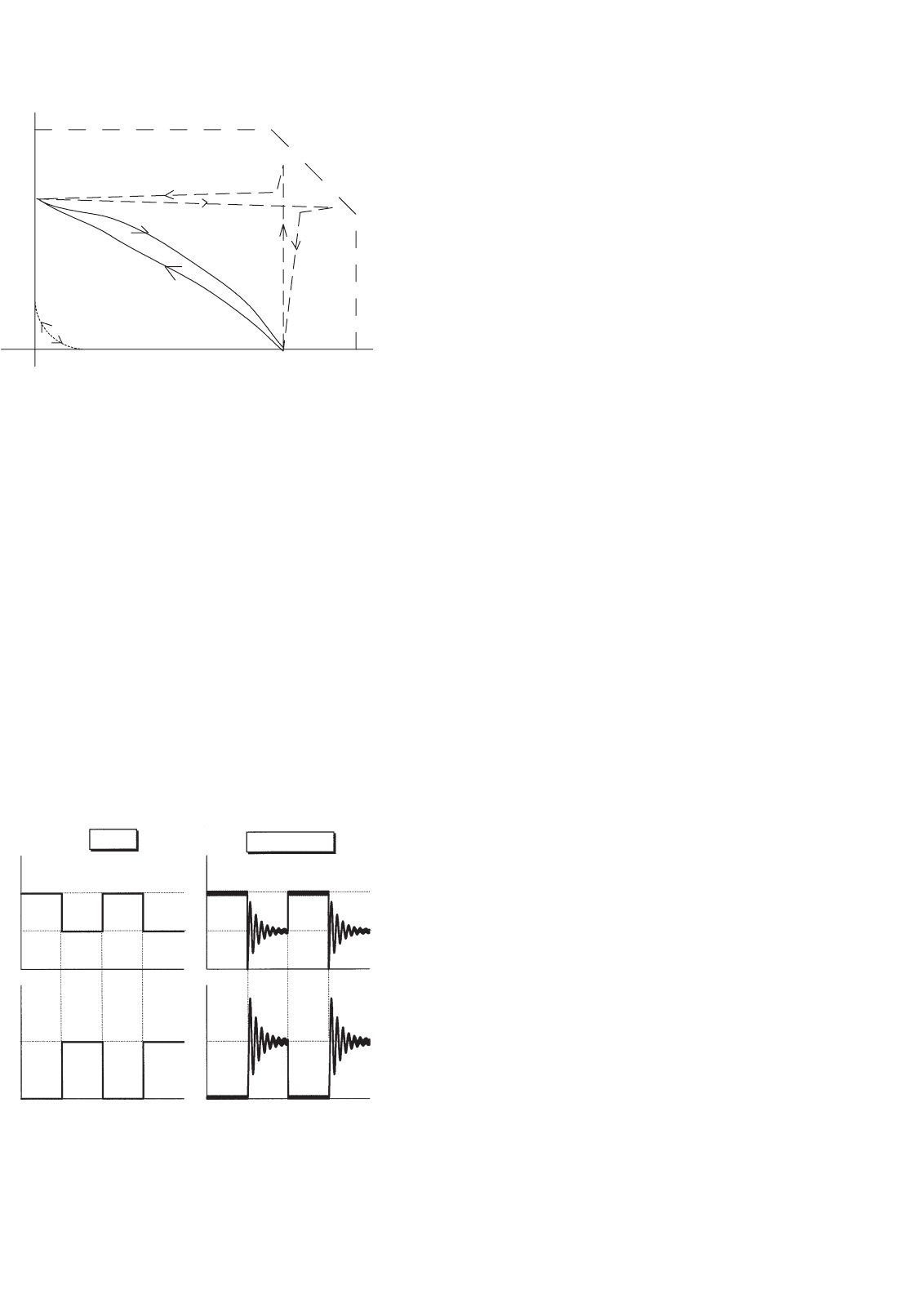
406 S. Y. Hui and H. S. H. Chung
I
V
Off
On
Soft-switching
Hard-switching
Safe Operating Area
snubbered
FIGURE 16.1 Typical switching trajectories of power switches.
high switching losses and stress. Dissipative passive snubbers
are usually added to the power circuits so that the dv/dt
and di/dt of the power devices could be reduced, and the
switching loss and stress be diverted to the passive snubber
circuits. However, the switching loss is proportional to the
switching frequency, thus limiting the maximum switching
frequency of the power converters. Typical converter switch-
ing frequency was limited to a few tens of kilo-Hertz (typically
20–50 kHz) in early 1980s. The stray inductive and capacitive
components in the power circuits and power devices still cause
considerable transient effects, which in turn give rise to electro-
magnetic interference (EMI) problems. Figure 16.2 shows ideal
IDEAL
PRACTICAL
I
s
I
s
I
o
I
o
V
s
V
s
V
in
V
in
FIGURE 16.2 Typical: (a) ideal and (b) practical switching waveforms.
switching waveforms and typical practical waveforms of the
switch voltage. The transient ringing effects are major causes
of EMI.
In the 1980s, lots of research efforts were diverted towards
the use of resonant converters. The concept was to incor-
porate resonant tanks in the converters to create oscillatory
(usually sinusoidal) voltage and/or current waveforms so
that zero-voltage switching (ZVS) or zero-current switch-
ing (ZCS) conditions can be created for the power switches.
The reduction of switching loss and the continual improve-
ment of power switches allow the switching frequency of
the resonant converters to reach hundreds of kilo-Hertz
(typically 100–500 kHz). Consequently, the size of mag-
netic components can be reduced and the power density
of the converters increased. Various forms of resonant con-
verters have been proposed and developed. However, most
of the resonant converters suffer several problems. When
compared with the conventional PWM converters, the res-
onant current and the voltage of resonant converters have
high peak values, leading to higher conduction loss and
higher V and I rating requirements for the power devices.
Also, many resonant converters require frequency modu-
lation (FM) for output regulation. Variable switching fre-
quency operation makes the filter design and control more
complicated.
In late 1980s and throughout 1990s, further improvements
have been made in converter technology. New generations
of soft-switched converters that combine the advantages of
conventional PWM converters and resonant converters have
been developed. These soft-switched converters have switching
waveforms similar to those of conventional PWM convert-
ers except that the rising and falling edges of the waveforms
are “smoothed” with no transient spikes. Unlike the reso-
nant converters, new soft-switched converters usually utilize
the resonance in a controlled manner. Resonance is allowed
to occur just before and during the turn-on and turn-off
processes so as to create ZVS and ZCS conditions. Other
than that, they behave just like conventional PWM con-
verters. With simple modifications, many customized control
integrated circuits (ICs) designed for conventional convert-
ers can be employed for soft-switched converters. Because
the switching loss and stress have been reduced, soft-switched
converter can be operated at the very high frequency (typ-
ically 500 kHz to a few Mega-Hertz). Soft-switching con-
verters also provide an effective solution to suppress EMI
and have been applied to DC–DC, AC–DC, and DC–AC
converters. This chapter covers the basic technology of
resonant and soft-switching converters. Various forms of
soft-switching techniques such as ZVS, ZCS, voltage clamp-
ing, zero-voltage transition methods, etc. are addressed. The
emphasis is placed on the basic operating principle and prac-
ticality of the converters without using much mathematical
analysis.
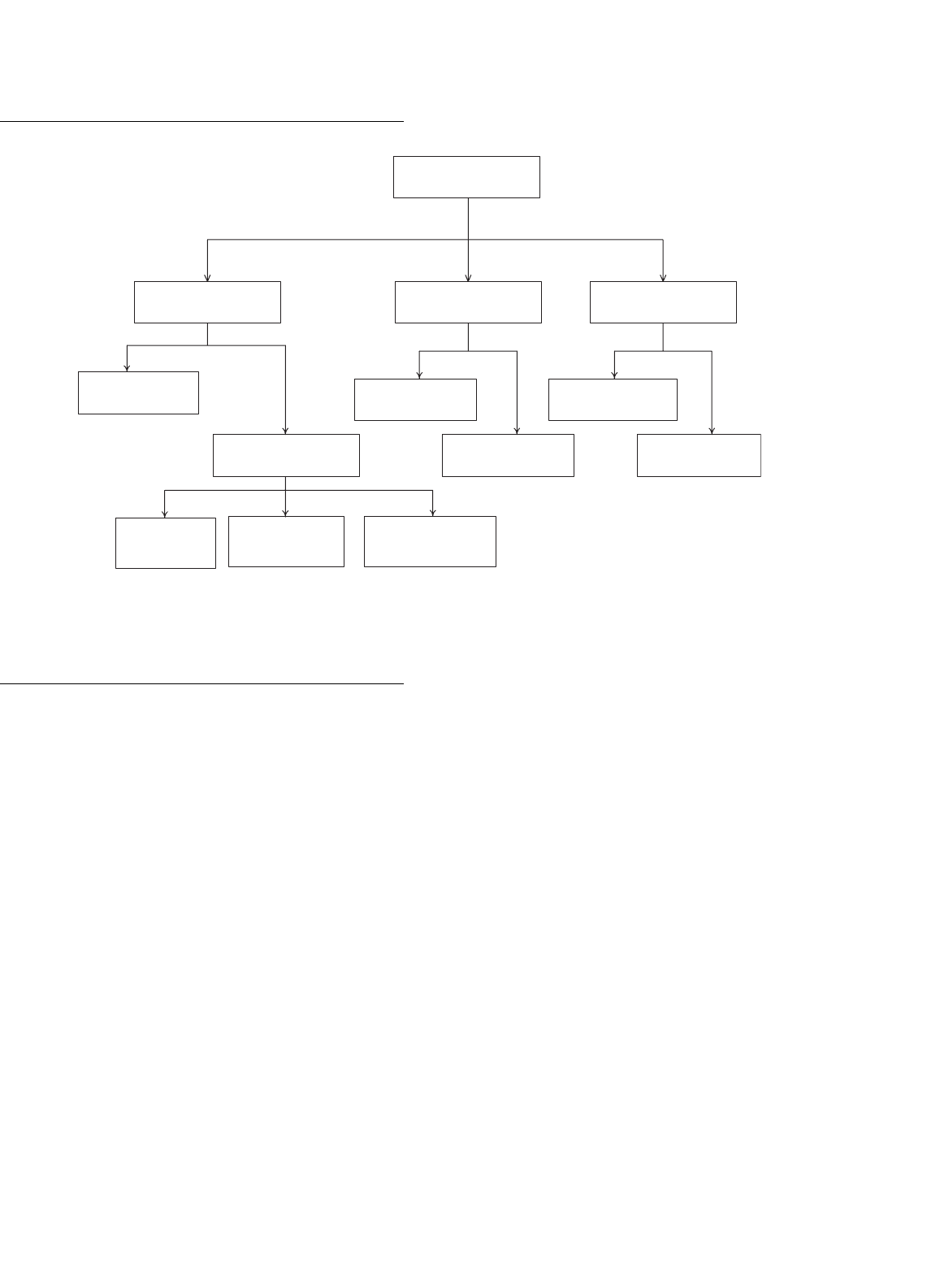
16 Resonant and Soft-switching Converters 407
16.2 Classification
Resonant-type DC-DC
Converters
Conventional Resonant
Converters
Quasi-resonant
Converters
Multi-resonant
Converters
Phase
Shift-modulated
Load-resonant
Converters
Constant Frequency
Operation
Variable Frequency
Operation
Series Resonant
Converters
Parallel Resonant
Converters
Series–Parallel
Resonant Converters
Constant Frequency
Operation
Variable Frequency
Operation
16.3 Resonant Switch
Prior to the availability of fully controllable power switches,
thyristors were the major power devices used in power elec-
tronic circuits. Each thyristor requires a commutation circuit,
which usually consists of a LC resonant circuit, for forcing the
current to zero in the turn-off process [1]. This mechanism
is in fact a type of zero-current turn-off process. With the
recent advancement in semiconductor technology, the voltage
and current handling capability, and the switching speed of
fully controllable switches have significantly been improved.
In many high power applications, controllable switches such
as gate turn-offs (GTOs) and insulated gate bipolar transis-
tors (IGBTs) have replaced thyristors [2, 3]. However, the use
of resonant circuit for achieving ZCS and/or ZVS [4–8] has
also emerged as a new technology for power converters. The
concept of resonant switch that replaces conventional power
switch is introduced in this section.
A resonant switch is a sub-circuit comprising a semicon-
ductor switch S and resonant elements, L
r
and C
r
[9–11].
The switch S can be implemented by a unidirectional or
bidirectional switch, which determines the operation mode
of the resonant switch. Two types of resonant switches
[12], including zero-current (ZC) resonant switch and
zero-voltage (ZV) resonant switches, are shown in Figs. 16.3
and 16.4, respectively.
16.3.1 ZC Resonant Switch
In a ZC resonant switch, an inductor L
r
is connected in series
with a power switch S in order to achieve zero-current switch-
ing (ZCS). If the switch S is a unidirectional switch, the switch
current is allowed to resonate in the positive half cycle only.
The resonant switch is said to operate in half-wave mode. If
a diode is connected in anti-parallel with the unidirectional
switch, the switch current can flow in both directions. In this
case, the resonant switch can operate in full-wave mode. At
turn-on, the switch current will rise slowly from zero. It will
then oscillate, because of the resonance between L
r
and C
r
.
Finally, the switch can be commutated at the next zero current
duration. The objective of this type of switch is to shape the
switch current waveform during conduction time in order to
create a zero-current condition for the switch to turn off [13].
16.3.2 ZV Resonant Switch
In a ZV resonant switch, a capacitor C
r
is connected in parallel
with the switch S for achieving zero-voltage switching (ZVS).
